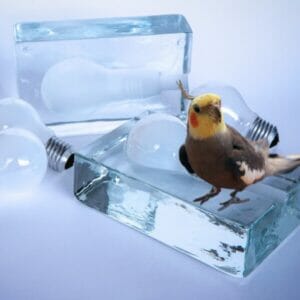
How Dangerous is Wi-Fi for My Parrot or Pet Bird?
Last Updated on by Mitch Rezman
Subject: wi-fi safety
Description:
HI! Love the newsletter! have a question about wi-fi–how dangerous is it for my parrot? I do not use it often and since I was upgraded to 5g, I keep the computer unplugged when not in use and use ethernet.
Most of the time. What is the deal? Have heard many different things. Should I downgrade to 4g? Also, the toaster is dying–need a new product–very concerned about non-stick–call and research products but.
People will say anything to sell something–have any advice?
Let’s start with the “non-stick” question.
When most people think “Teflon” they are picturing cookware in their mind’s eye so I wrote a post on the many hidden dangers of Teflon.
Bird Teflon Dangers You Didn’t Know and Other Household Perils
A simple answer to your WiFi question would be,
You run a greater risk of tripping over internet cables and hurting yourself in a wired scenario than being near WiFi.
For the record, we run the majority of our computer infrastructure on cat5 and cat6 wired cables primarily because it’s much faster and safer.
If you want a bit more of the back story on WiFi safety:
WiFi operates through the utilization of radio waves that possess a frequency comparable to microwaves.
The resemblance between these radio waves and the waves produced by microwave ovens, which exhibit the ability to dramatically transform popcorn kernels has led to legitimate apprehensions regarding the potential adverse health effects resulting from WiFi exposure.
Thankfully, although WiFi waves are quite common, their emission intensity is much lower compared to that of microwaves used in ovens. Consequently, they lack the ability to generate a similar level of heat.
If you really want to get down and nerdy,
The available research on this subject is largely indefinite, focusing on networks that operate on specifications distinct from those used in typical home WiFi setups.
Research has been conducted on ELF (Extremely Low Frequency), which pertains to frequencies that are exceptionally low, such as those emitted by power lines or household appliances.
Typically, these frequencies fall below the range of 300 MHz and even extend to much lower levels.
There is another field of study that I have explored, which involves the examination of cell phone networks.
Typically operating within the range of 900-1800 MHz, these networks are supported by cell phone towers.
These towers typically emit an effective radiated power of 5-10 W, although this power diminishes rapidly as you move away from the antenna.
In terms of their transmission abilities, cell phones usually emit between 0.5 W to 3 W, although this range may vary based on factors such as the manufacturer, among others.
WiFi typically operates at two different frequencies, namely 2.4 GHz (equivalent to 2400 MHz) or 5.6 GHz (equivalent to 5600 MHz), for comparison.
According to the specifications provided by a WiFi base station, it has the capability to emit a maximum power of 20 dBm (equivalent to 0.1 Watts) on each of these frequencies.
In the mid-00s, a duo of scientists, Balmori and Hallberg, conducted an investigation on sparrows in Spain.
The results of their study revealed a correlation between the amplification of electronic magnetic fields and a decline in the overall well-being of sparrows. This, in turn, led to adverse effects on their breeding outcomes, indicating a significant impact on the bird population.
A study conducted in Belgium by Everaert and Bauwens yielded comparable findings.
One predicament arising from these research endeavors lies in the challenge of discerning the extent to which the decline in health or outcomes can be attributed to electromagnetic fields (EMF), as opposed to the escalating urban environment resulting in habitat loss and diminishing food sources.
In their 2007 study, Reijt and colleagues conducted research on the breeding behavior of birds residing in nesting boxes near a military radar station, while also comparing them to a control location.
The researchers noted that the levels of exposure in these areas ranged from 2.0 to 5.0 W/m2. Surprisingly, no notable changes were observed in the breeding biology of these birds.
Nonetheless, an interesting outcome emerged as the ratio of blue tits to great tits showed a distinct shift in the vicinity of the military radar station when compared to the control location.
I promised you nerdy…
Hence, one viewpoint regarding this research and the studies conducted on house sparrows suggests that the presence of electromagnetic fields could potentially dissuade certain avian species from reproducing in those regions.
On the contrary, these fields might also serve as a catalyst for attracting other bird species to construct their nests in areas where radiofrequency electromagnetic fields are more concentrated.
While the existing safety guidelines predominantly cover the impact of energy waves on heating flesh, there is no need to worry about the thermal aspect of these radiation forms.
Nonetheless, ongoing investigations are focused on understanding the non-thermal effects.
Written and Approved by the Windy City Parrot Content Team
Author Profile
Latest entries
 The Traveling BirdJune 26, 2025Can You Name 5 Parrot Species That Are Living Wild in the USA?
The Traveling BirdJune 26, 2025Can You Name 5 Parrot Species That Are Living Wild in the USA? Bird BehaviorJune 26, 2025How is it Parrots Are Problem Solvers Social Animals and Even Use Tools?
Bird BehaviorJune 26, 2025How is it Parrots Are Problem Solvers Social Animals and Even Use Tools? Bird & Parrot AnatomyJune 25, 2025How a Tiny Chemical Modification Makes Parrots Nature’s Living Paintings
Bird & Parrot AnatomyJune 25, 2025How a Tiny Chemical Modification Makes Parrots Nature’s Living Paintings PigeonsJune 20, 2025How Do Parrots Thrive in Cities Outside Their Native Habitats?
PigeonsJune 20, 2025How Do Parrots Thrive in Cities Outside Their Native Habitats?


